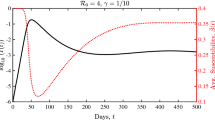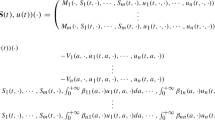Abstract
We study the basic reproduction numbers for a class of reaction-diffusion epidemic models that are developed from autonomous ODE systems. We present a general numerical framework to compute such basic reproduction numbers; meanwhile, the numerical formulation provides useful insight into their characterizations. Using matrix analysis, we show that the basic reproduction numbers are the same for these PDE models and their associated ODE models in several important cases that include, among others, a single infected compartment, constant diffusion rates, uniform diffusion patterns among the infected compartments, and partial diffusion in the system.


Similar content being viewed by others
References
Allen LJS, Bolker BM, Lou Y, Nevai AL (2008) Asymptotic profiles of the steady states for an SIS epidemic reaction-diffusion model. Discrete Contin Dyn Syst 21:1–20
Bertuzzo E, Casagrandi R, Gatto M, Rodriguez-Iturbe I, Rinaldo A (2010) On spatially explicit models of cholera epidemics. J R Soc Interface 7:321–333
Cantrell RS, Cosner C (1991) The effects of spatial heterogeneity in population dynamics. J Math Biol 29:315–338
Cantrell RS, Cosner C (2003) Spatial ecology via reaction-diffusion equations. Wiley, Hoboken
Chen S, Shi J (2020) Asymptotic profiles of basic reproduction number for epidemic spreading in heterogeneous environment. SIAM J Appl Math 80:1247–1271
Diekmann O, Heesterbeek JAP, Metz AJ (1990) On the definition and the computation of the basic reproduction ratio \(R_0\) in models for infectious diseases in heterogeneous population. J Math Biol 28:365–382
Ge J, Lei C, Lin Z (2017) Reproduction numbers and the expanding fronts for a diffusion-advection SIS model in heterogeneous time-periodic environment. Nonlinear Anal Real World Appl 33:100–120
Golub GH, Van Loan CF (1996) Matrix computations, 3rd edn. Johns Hopkins University Press, Baltimore
Horn RA, Johnson CR (1985) Matrix analysis. Cambridge University Press, Cambridge
Kim KI, Lin Z, Zhang Q (2013) An SIR epidemic model with free boundary. Nonlinear Anal Real World Appl 14:1992–2001
Lou Y, Zhao X-Q (2011) A reaction-diffusion malaria model with incubation period in the vector population. J Math Biol 62:543–568
Magal P, Webb GF, Wu Y (2019) On the basic reproduction number of reaction-diffusion epidemic models. SIAM J. Appl. Math. 79:284–304
Mukandavire Z, Liao S, Wang J, Gaff H, Smith DL, Morris JG (2011) Estimating the reproductive numbers for the 2008–2009 cholera outbreaks in Zimbabwe. Proc. Nat. Acad. Sci. USA 108:8767–8772
Peng R, Zhao X-Q (2012) A reaction-diffusion SIS epidemic model in a time-periodic environment. Nonlinearity 25:1451–1471
Posny D, Wang J (2014) Modeling cholera in periodic environments. J Biol Dyn 8(1):1–19
Rinaldo A, Bertuzzo E, Mari L, Righetto L, Blokesch M, Gatto M, Casagrandi R, Murray M, Vesenbeckh SM, Rodriguez-Iturbe I (2012) Reassessment of the 2010–2011 Haiti cholera outbreak and rainfall-driven multiseason projections. Proc Nat Acad Sci USA 109:6602–6607
Richtmyer RD, Morton KW (1994) Difference methods for initial-value problems, 2nd edn. Krieger Publication Company, Malabar
Saad Y (2011) Numerical methods for large eigenvalue problems, Revised edn. SIAM, Philadelphia
Sauty JP (1980) An analysis of hydrodispersive transfer in aquifers. Water Resour Res 16:145–158
Song P, Lou Y, Xiao Y (2019) A spatial SEIRS reaction-diffusion model in heterogeneous environment. J Differ Equ 267:5084–5114
Sposito GW, Jury WA, Gupta VK (1986) Fundamental problems in the stochastic convection-dispersion model of solute transport in aquifer and field soils. Water Resour Res 22:77–88
Taylor GI (1953) Dispersion of solute matter in solvent flowing through a tube. Proc R Soc Ser A 219:186–203
Thieme HR (2009) Spectral bound and reproduction number for infinite-dimensional population structure and time heterogeneity. SIAM J Appl Math 70:188–211
Thomas JW (1995) Numerical partial differential equations: finite difference methods. Springer, New York
Tien JH, Earn DJ (2010) Multiple transmission pathways and disease dynamics in a waterborne pathogen model. Bull Math Biol 72:1506–1533
van den Driessche P, Watmough J (2002) Reproduction numbers and sub-threshold endemic equilibria for compartmental models of disease transmission. Math Biosci 180:29–48
Wang F-B, Shi J, Zou X (2015) Dynamics of a host-pathogen system on a bounded spatial domain. Commun Pure Appl Anal 14:2535–2560
Wang X, Gao D, Wang J (2015) Influence of human behavior on cholera dynamics. Math Biosci 267:41–52
Wang X, Posny D, Wang J (2016) A reaction-convection-diffusion model for cholera spatial dynamics. Discrete Contin Dyn Syst Ser B 21:2785–2809
Wang W, Zhao X-Q (2012) Basic reproduction numbers for reaction-diffusion epidemic models. SIAM J Appl Dyn Syst 11:1652–1673
Wu Y, Zou X (2018) Dynamics and profile of a diffusive host-pathogen system with distinct dispersal rates. J Differ Equ 264:4989–5024
Yamazaki K, Wang X (2016) Global well-posedness and asymptotic behavior of solutions to a reaction-convection-diffusion cholera epidemic model. Discrete Contin Dyn Syst Ser B 21:1297–1316
Yang C, Lolika P, Mushayabasa S, Wang J (2017) Modeling the spatiotemporal variations in brucellosis transmission. Nonlinear Anal Real World Appl 38:49–67
Yu X, Zhao X-Q (2016) A nonlocal spatial model for Lyme disease. J Differ Equ 261:340–372
Zhao L, Wang Z-C, Ruan S (2018) Traveling wave solutions in a two-group SIR epidemic model with constant recruitment. J Math Biol 77:1871–1915
Acknowledgements
This work was partially supported by the National Institutes of Health under Grant Number 1R15GM131315. The authors are grateful to the two anonymous referees for their helpful comments that have significantly improved the original manuscript.
Author information
Authors and Affiliations
Corresponding author
Additional information
Publisher's Note
Springer Nature remains neutral with regard to jurisdictional claims in published maps and institutional affiliations.
Rights and permissions
About this article
Cite this article
Yang, C., Wang, J. Basic Reproduction Numbers for a Class of Reaction-Diffusion Epidemic Models. Bull Math Biol 82, 111 (2020). https://doi.org/10.1007/s11538-020-00788-x
Received:
Accepted:
Published:
DOI: https://doi.org/10.1007/s11538-020-00788-x




